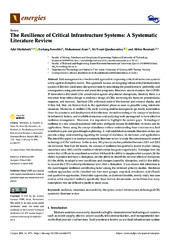The Resilience of Critical Infrastructure Systems: A Systematic Literature Review
Permanent lenke
https://hdl.handle.net/10037/21652Dato
2021-03-12Type
Journal articleTidsskriftartikkel
Peer reviewed
Sammendrag
Risk management is a fundamental approach to improving critical infrastructure systems’ safety against disruptive events. This approach focuses on designing robust critical infrastructure systems (CISs) that could resist disruptive events by minimizing the possible events’ probability and consequences using preventive and protective programs. However, recent disasters like COVID-19 have shown that most CISs cannot stand against all potential disruptions. Recently there is a transition from robust design to resilience design of CISs, increasing the focus on preparedness, response, and recovery. Resilient CISs withstand most of the internal and external shocks, and if they fail, they can bounce back to the operational phase as soon as possible using minimum resources. Moreover, in resilient CISs, early warning enables managers to get timely information about the proximity and development of distributions. An understanding of the concept of resilience, its influential factors, and available evaluation and analyzing tools are required to have effective resilience management. Moreover, it is important to highlight the current gaps. Technological resilience is a new concept associated with some ambiguity around its definition, its terms, and its applications. Hence, using the concept of resilience without understanding these variations may lead to ineffective pre- and post-disruption planning. A well-established systematic literature review can provide a deep understanding regarding the concept of resilience, its limitation, and applications. The aim of this paper is to conduct a systematic literature review to study the current research around technological CISs’ resilience. In the review, 192 primary studies published between 2003 and 2020 are reviewed. Based on the results, the concept of resilience has gradually found its place among researchers since 2003, and the number of related studies has grown significantly. It emerges from the review that a CIS can be considered as resilient if it has (i) the ability to imagine what to expect, (ii) the ability to protect and resist a disruption, (iii) the ability to absorb the adverse effects of disruption, (iv) the ability to adapt to new conditions and changes caused by disruption, and (v) the ability to recover the CIS’s normal performance level after a disruption. It was shown that robustness is the most frequent resilience contributing factor among the reviewed primary studies. Resilience analysis approaches can be classified into four main groups: empirical, simulation, index-based, and qualitative approaches. Simulation approaches, as dominant models, mostly study real case studies, while empirical methods, specifically those that are deterministic, are built based on many assumptions that are difficult to justify in many cases.
Forlag
MDPISitering
Mottahedi, Sereshki, Ataei M, Nouri a, Barabadi A. The Resilience of Critical Infrastructure Systems: A Systematic Literature Review. Energies. 2021Metadata
Vis full innførselSamlinger
Copyright 2021 The Author(s)


 English
English norsk
norsk